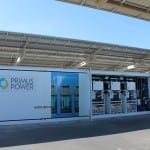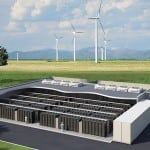The energy storage sector is taking off its training wheels. And while that may be a good thing, it comes with some risks. Two senior executives in the energy storage industry who spoke to POWER at the Energy Storage North America (ESNA) conference in San Jose, Calif., Sept 30–Oct. 2, described a promising—but challenging—future.
John Jung is president and CEO of Greensmith Energy Management Systems, which makes battery management software. It’s no longer enough, he explained, for end users to purchase standalone systems, connect them to the grid, and expect a good return on investment. Owners of battery systems need to think holistically about how they will function, both immediately and over time, and what other systems they will be expected to work with.
Having worked in energy storage for more than six years, Jung qualifies as an old hand. He’s seen the sector evolve slowly, then suddenly explode over the last 12 months. “For the first five years, it didn’t seem like there was much of a market, but since then it’s just been going crazy.”
What’s changed things is the realization that storage is now economic for many applications and that the right system in the right place can begin generating revenue from Day 1—provided it’s set up correctly.
Jung says customers used to just be focused on the storage, but no more. “They’re using us not just for our technology but to help them decide, ‘What can we make money doing?’”
That money is serious.
With California having ordered up 1.3 GW of storage for its investor-owned utilities, and an unspecified but definite level for the remaining power providers in the state, California is in the midst of a new gold rush—in energy storage.
Greensmith will be commissioning 23 MW of battery systems in 2014 that will be run by its fourth-generation GEMS software suite. The GEMS platform is a brand-agnostic, hardware-agnostic system designed to give storage owners increased flexibility and responsiveness, ultimately reducing costs and opening up new revenue streams.
Growing Support Services
Part of the reason Greensmith has seen a surge in demand for its services is because battery manufacturers have started to realize that, while good battery management software is essential, software engineering is frequently outside the core competency of a hardware manufacturer. And improperly integrated storage systems are quite capable of self-destructing.
“If you’re a company whose DNA, and whose people and processes are about manufacturing components,” Jung said, “that’s not the same thing as integration and software. You see that time and time again.”
This has led some manufacturers to direct customers toward third-party software support like Greensmith. And that means that those customers need think well beyond the capacity of the system and toward how exactly it will be used over time. Jung said it’s better to get a system precisely fitted to the owner’s needs and usage, rather than buying overcapacity, assuming performance will degrade over time.
A good support structure can future-proof storage deployments, shifting roles and keeping a battery useful even when it may no longer be cutting edge and capacity has degraded.
But the energy storage gold rush has Jung a bit concerned.
“There’s a lot of fear and greed with any kind of market. But [with storage] I think there’s too much greed and not enough fear. I think a lot of people are underestimating how many companies are coming in,” he said. “You want to be sure the industry puts its best foot forward.”
And in that, there’s a risk with too many early entrants. “If there’s a catastrophic failure, there’s no history, it’s the first thing people hear. So the worst thing that could happen to this industry is that you have a company coming in that doesn’t really know what they’re doing, and puts a system into some building that has a bad outcome, and it gets into the newspapers or whatever, that’s what this industry should be worried about.”
Out of the Shadows
John Zahurancik, president of AES Energy Storage, acknowledged some of these challenges, but is more confident the industry will face them successfully. AES is developing some very large storage projects, some up to 100 MW in capacity, such as a major installation backing up wind generation in Northern Ireland, and has seen proposals as large as 400 MW, Zahurancik said.
Zahurancik sees energy storage positioned to challenge a lot of traditional solutions, not just generation but also ancillary services like frequency regulation and smoothing output. “There’s a lot of services that are set up for that, and storage is able to make the most of those jobs, and do them more effectively, more cost-effectively, and do it without emissions.”
That means not being stuck in a niche, but being an integral part of the grid.
“If you look at the kinds of things we built combustion turbines for in the past,” Zahurancik said, “this is a better way to do it.”
With the average combustion turbine seeing capacity factors under 10%, it’s suddenly more difficult to justify compared to a storage solution that can be operating and generating revenue around the clock. It’s even more compelling given the number of vendors at ESNA presenting technology that can be delivered at turnkey costs under $1,000/kWh.
Generators and utilities typically view combustion turbines as essentially insurance policies, Zahurancik said. “But you can buy this insurance policy in storage and it can do more.”
The other issue is that in many areas, “the problem is not a lack of power but an abundance of it,” because of increasing renewable generation. Traditional generation resources can’t directly cope with overgeneration conditions, but storage can. The object of the AES project in Northern Ireland, for example, is “making sure they can take all the wind generation they’re paying for.”
Zahurancik acknowledged the rush of new entrants, but suggested the industry had learned from the early missteps of renewable developers a decade or more ago. “The quality of applicants that [the California Public Utilities Commission] is getting, and their experience, is actually much greater than in the early days of renewables,” he said. This process “should go faster because of that happening.”
It’s a rush being seen outside California as well. According to a recent report from Navigant Research released during ESNA, the grid-scale energy storage market is expected to reach $15.6 billion annually by 2024, with global installed capacity reaching 20.8 GW the same year.
Challenges or not, Big Storage is coming.
—Thomas W. Overton, JD is a POWER associate editor.









